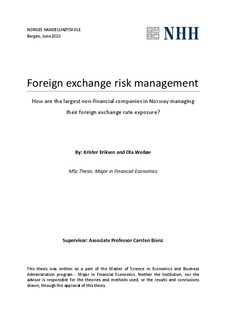| dc.description.abstract | The purpose of this thesis is to investigate how the largest non-financial companies in Norway manage their foreign exchange rate exposure. This is investigated through the use of a survey distributed to a sample the largest non-financial firms in Norway.
According to our results, the largest non-financial companies in Norway have a predefined strategy for managing foreign exchange risk, which is defined by the board of directors or by the management in the organisation. The companies’ main motivation for managing foreign exchange risk is to reduce fluctuations in income, costs or cash flow, and short term derivatives are more commonly used than derivatives with a long horizon. They also have a high degree of natural hedging, which is influenced by the number of foreign subsidiaries and the number of countries they are spread across. Those who only use operational hedging techniques have subsidiaries in more countries than those only using financial derivatives and those using both. The companies in the shipping industry use more types of derivatives than the other industries, while companies in the oil and gas industry use less | en |
